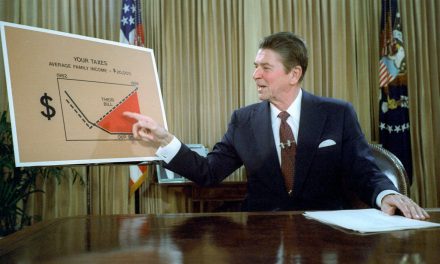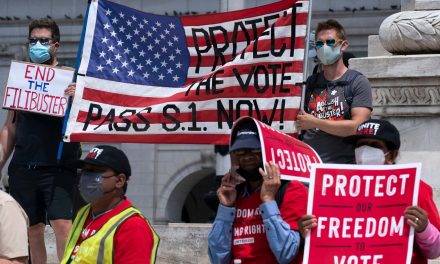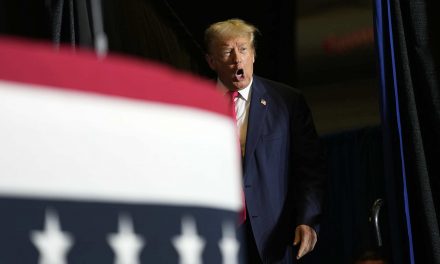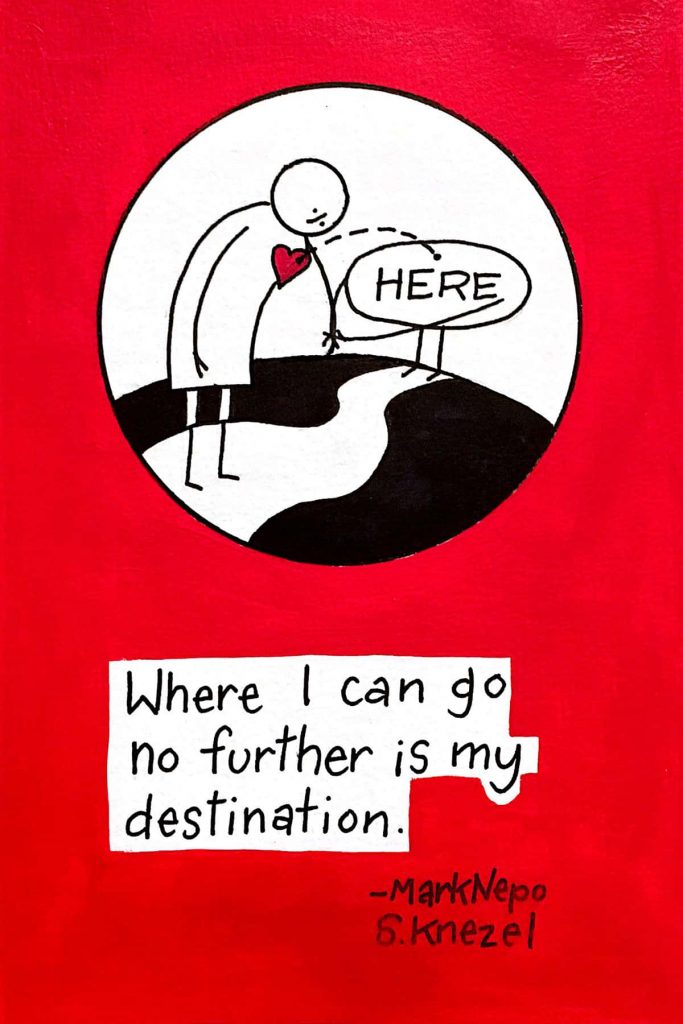
“The only thing wrong with the U.S. economy is the failure of the Republican Party to play Santa Claus.” – Jude Wanniski, March 6, 1976
The stock market is falling, in part a reaction to GOP threats to shut down the government: it’s all part of their plan.
Treasury Secretary Janet Yellen last week warned us that the GOP is about to use Jude Wanniski’s “Two Santa Clauses” fraud again to damage Biden’s economy and our standing in the world. And, sure enough, Mitch McConnell verified it when he said last week there would be “zero” Republican votes to raise the debt ceiling.
Yellen responded yesterday by telling The Wall Street Journal that if the Republicans force a shutdown of the U.S. government like they did to Obama in 2011, “We would emerge from this crisis a permanently weaker nation.” But the GOP is adamant: they have their strategy and they’re sticking to it.
Here’s how it works, laid it out in simple summary:
First, the Two Santas strategy dictates, when Republicans control the White House they must spend money like a drunken Santa and cut taxes to run up the U.S. debt as far and as fast as possible.
This produces three results: it stimulates the economy thus making people think that the GOP can produce a good economy; it raises the debt dramatically; and it makes people think that Republicans are the “tax-cut Santa Clauses.”
Second, when a Democrat is in the White House, Republicans must scream about the national debt as loudly and frantically as possible, freaking out about how “our children will have to pay for it!” and “we have to cut spending to solve the crisis!” Shut down the government, crash the stock market, and damage US credibility around the world if necessary to stop Democrats from spending money.
This will force the Democrats in power to cut their own social safety net programs and even Social Security, thus shooting their welfare-of-the-American-people Santa Claus right in the face.
And, sure enough, here we are now with a Democrat in the White House. Following their Two Santas strategy, Republicans are again squealing about the national debt and refusing to raise the debt ceiling, imperiling Biden’s economic recovery as well as his Build Back Better plans.
And, once again, the media is covering it as a “Biden Crisis!” rather than what it really is: a cynical political and media strategy devised by Republicans in the 1970s, fine-tuned in the 1980s and 1990s, and rolled out every time a Democrat is in the White House.
Jude Wanniski hatches the scheme that saves the GOP
Republican strategist Jude Wanniski first proposed his Two Santa Clauses strategy in The Wall Street Journal in 1974, after Richard Nixon resigned in disgrace and the future of the Republican Party was so dim that books and articles were widely suggesting the GOP was about to go the way of the Whigs. There was genuine despair across the Republican Party, particularly when Jerry Ford couldn’t even beat an unknown peanut farmer from rural Georgia for the presidency.
Wanniski reasoned the reason the GOP was losing so many elections was not just because of Nixon’s corruption, but mostly because the Democrats had been viewed since the New Deal as the Santa Claus party.
On the other hand, the GOP, he said, was widely seen as the party of Scrooge because they publicly opposed everything from Social Security and Medicare to unemployment insurance and food stamps.
The Democrats, he noted, got to play Santa Claus for decades when they passed out Social Security and Unemployment checks — both programs of FDR’s Democratic New Deal — as well as their “big government” projects like roads, bridges, schools and highways that gave a healthy union paycheck to construction workers and made our country shine.
Even worse, Democrats kept raising taxes on businesses and rich people to pay for all this stuff — and those taxes on the rich didn’t have any effect at all on working people (wages were steadily going up until the Reagan Revolution, in fact).
It all added, Wanniski theorized, to the perception that the Democrats were the true party of Santa Claus, using taxes from the morbidly rich to fund programs for the poor and the working class.
Americans loved the Democrats back then. And every time Republicans railed against these programs, they lost elections.
Therefore, Wanniski concluded, the GOP had to become a Santa Claus party, too. But because the Republicans hated the idea of helping out working people, they had to come up with a way to convince average voters that they, too, have the Santa spirit. But what?
“Tax cuts!” said Wanniski.
To make this work, the Republicans would first have to turn the classical world of economics — which had operated on a simple demand-driven equation for seven thousand years — on its head. Everybody understood that demand — “working-class wages” — drove economies because working people spent most of their money in the marketplace, producing “demand” for factory output goods and services.
To lay the ground for Two Santa Clauses, in 1974 Wanniski invented a new phrase — “Supply-Side Economics” — and said the reason economies grew wasn’t because people had good union jobs and thus enough money to buy things but, instead, because business made things available for sale, thus tantalizing people to part with their money.
The more products (supply) there were in the stores, he said, the faster the economy would grow. And the more money we gave rich people and their corporations (via tax cuts) the more stuff (supply) they’d generously produce for us to think about buying. At a glance, this move by the Republicans seems irrational, cynical and counterproductive. It certainly defies classic understandings of economics. But if you consider Jude Wanniski’s playbook, it makes complete sense.
To help, Arthur Laffer took that equation a step further with his famous napkin scribble. Not only was supply-side a rational concept, Laffer suggested, but as taxes went down, revenue to the government would go up. Neither concept made any sense — and time has proven both to be colossal idiocies — but if Americans would buy into it all they offered the Republican Party a way out of the wilderness.
Ronald Reagan was the first national Republican politician to fully embrace the Two Santa Clauses strategy. He said straight out that if he could cut taxes on rich people and businesses, those “job creators” would use their extra money to build new factories so all that new stuff “supplying” the economy would produce faster economic growth.
George HW Bush — like most Republicans in 1980 who hadn’t read Wanniski’s piece in The Wall Street Journal — was horrified. Ronald Reagan was proposing “Voodoo Economics,” said Bush in the primary campaign, and Wanniski’s supply-side and Laffer’s tax-cut theories would throw the nation into debt while producing nothing in growth.
But Wanniski had been doing his homework on how to sell “voodoo” supply-side economics.
Democrats, Wanniski told the GOP, had been “Santa Clauses” since 1933 by giving people things. From union jobs to food stamps, new schools and Social Security, the American people loved the “toys” the Democratic Santas brought every year as well as the growing economy that increasing union wages and the money from social programs in middle class hands.
Republicans could stimulate the economy by throwing trillions at defense contractors, Jude’s theory went: spending could actually increase without negative repercussions and that money would trickle down to workers through the defense industry, which had reacted to Eisenhower’s warning by building factories in every single one of America’s 435 congressional districts.
Plus, Republicans could be double Santa Clauses by cutting people’s taxes!
For working people the tax cuts would only be a small token — a few hundred dollars a year at the most — but Republicans would heavily market them to the media and in political advertising. And the tax cuts for the rich, which weren’t to be discussed in public, would amount to hundreds of billions or even trillions of dollars, part of which would be recycled back to the GOP as campaign contributions.
There was no way, Wanniski said, that the Democrats could ever win again. They’d be forced into the role of Santa-killers if they acted responsibly by raising taxes, or, even better, anti-Santas by cutting spending on their own social programs. Either one would lose them elections.
Reagan, Greenspan, Wanniski, and Laffer took the federal budget deficit from under a trillion dollars in 1980 to almost three trillion by 1988, and back then a dollar could buy far more than it buys today. They and George HW Bush ran up more debt in twelve years than every president in history up till that time, from George Washington to Jimmy Carter, combined.
Surely this would both “starve the beast” of the American government and force the Democrats to make the politically suicidal move of becoming deficit hawks. And that was just how it turned out.
Bill Clinton, the first Democrat they blindsided with Two Santas, had run on an FDR-like platform of a “New Covenant” with the American people that would strengthen the institutions of the New Deal, strengthen labor, and institute a national single-payer health care system.
A few weeks before his inauguration, however, Wanniski-insider Alan Greenspan and Goldman Sachs co-chairman Robert Rubin sat him down and told him the facts of life: Reagan and Bush had run up such a huge deficit that he was going to have to raise taxes and cut the size of government.
Clinton took their advice to heart, raised taxes, balanced the budget, and cut numerous programs, declaring an “end to welfare as we know it” and, in his second inaugural address, an “end to the era of big government.”
Clinton was the anti-Santa Claus, and the result was an explosion of Republican wins across the country as Republican politicians campaigned on a platform of supply-side tax cuts and pork-rich spending increases.
State after state turned red, and the Republican Party rose to take over, ultimately, every single lever of power in the federal government, from the Supreme Court to the White House.
Looking at the wreckage of the Democratic Party all around Clinton in 1999, Wanniski wrote a gloating memo that said, in part:
“We of course should be indebted to Art Laffer for all time for his Curve… But as the primary political theoretician of the supply-side camp, I began arguing for the ‘Two Santa Claus Theory’ in 1974. If the Democrats are going to play Santa Claus by promoting more spending, the Republicans can never beat them by promoting less spending. They have to promise tax cuts…”
Ed Crane, then-president of the Koch-funded Libertarian CATO Institute, noted in a memo that year:
“When Jack Kemp, Newt Gingrich, Vin Weber, Connie Mack and the rest discovered Jude Wanniski and Art Laffer, they thought they’d died and gone to heaven. In supply-side economics they found a philosophy that gave them a free pass out of the debate over the proper role of government. … That’s why you rarely, if ever, heard Kemp or Gingrich call for spending cuts, much less the elimination of programs and departments.”
Two Santa Clauses had gone mainstream. Never again would Republicans worry about the debt or deficit when they were in office; and they knew well how to scream hysterically about it and hook in the economically naïve press as soon as Democrats again took power.
When Jude Wanniski died, George Gilder celebrated the Reagan/Bush adoption of his Two Santas scheme in a Wall Street Journal eulogy:
“… Jude’s charismatic focus on the tax on capital gains redeemed the fiscal policies of four administrations. … Unbound by zero-sum economics, Jude forged the golden gift of a profound and passionate argument that the establishments of the mold must finally give way to the powers of the mind. … He audaciously defied all the Buffetteers of the trade gap, the moldy figs of the Phillips Curve, the chic traders in money and principle, even the stultifying pillows of the Nobel Prize.”
The Republicans got what they wanted from Wanniski’s work. They held power for forty years, made their donors trillions of dollars, and cut organized labor’s representation in the workplace from around a third of workers when Reagan came into office to around 6 percent of the non-governmental workforce today.
Think back to Ronald Reagan, who more than tripled the U.S. debt from a mere $800 billion to $2.6 trillion in his 8 years. That spending produced a massive stimulus to the economy, and the biggest non-wartime increase in American national debt in all of our history. Nary a peep from Republicans about that 218% increase in our debt; they were just fine with it and to this day claim Reagan presided over a “great” economy.
When five rightwingers on the Supreme Court gave the White House to George W. Bush he reverted to Wanniski’s “Two Santa” strategy and again nearly doubled the national debt, adding over a trillion in borrowed money to pay for his tax cut for billionaires, and tossing in two unfunded wars for good measure, which also added at least (long term) another $5 trillion.
There was not a peep about that debt from any high-profile in-the-know Republicans; in fact, Dick Cheney famously said, amplifying Wanniski’s strategy: “Reagan proved deficits don’t matter. We won the midterms. This is our due.”
Bush and Cheney raised the debt by 86% to over $10 trillion (and additional trillions in war debt that wasn’t put on the books until Obama entered office, so it looks like its his).
Then came Democratic President Barack Obama, and suddenly the GOP was hysterical about the debt again. So much so that they convinced a sitting Democratic president to propose a cut to Social Security (the “chained CPI”). Obama nearly shot the Democrats’ biggest Santa Claus, just like Wanniski predicted, until outrage from the Democratic base stopped him.
Next, Donald Trump raised our national debt by almost $7 trillion, but the GOP raised the debt ceiling without a peep every year for the first three years of his administration, and then suspended it altogether for 2020 (so, if Biden won, he’d have to justify raising the ceiling for 2 years’ worth of deficits, making it even more politically painful).
And now Republicans are getting ready to use the debt ceiling debate to drop their Two Santas bomb right onto President Joe Biden’s head. After all, it worked against Clinton and Obama. Why wouldn’t they use it again? And if Republican debt-ceiling default threats could lower the stock market, as they did to both Clinton and Obama, all the better: Republicans could just blame the Democrats in power.
Americans deserve to know how we have been manipulated, and by whom, for the past 40 years. Hopefully Democratic politicians and our media will begin to call the GOP out on Wanniski’s and Reagan’s Two Santa Clauses scam.
Huе12 Phоtоgraphy
© Thom Hartmann, used with permission. Originally published on The Hartmann Report as Santa Claus Is About To Drop a Bomb On Biden
Subscribe to The Hartmann Report directly and read the latest views about U.S politics and other fascinating subjects seven days a week.















